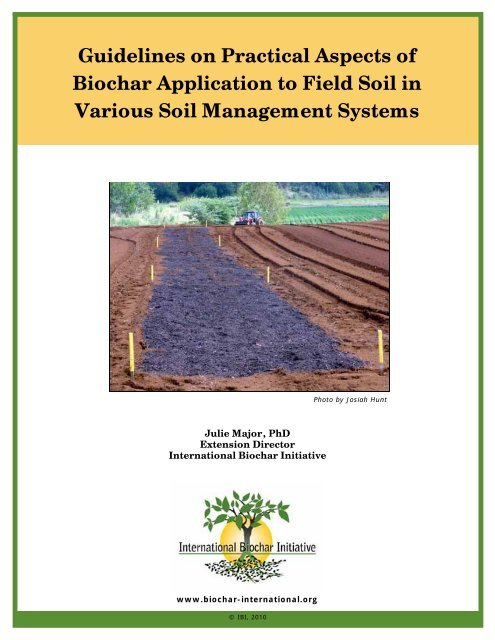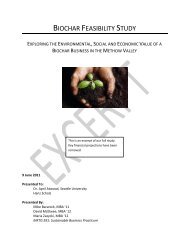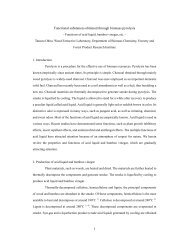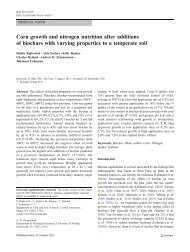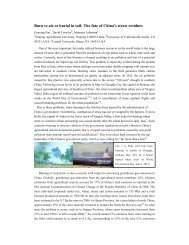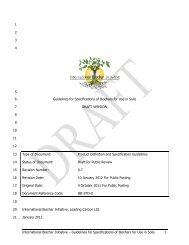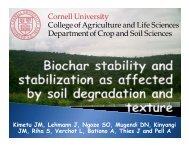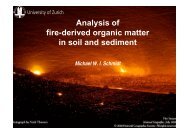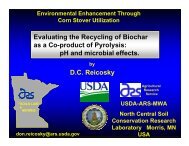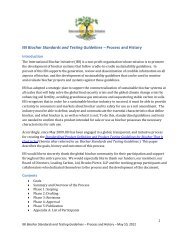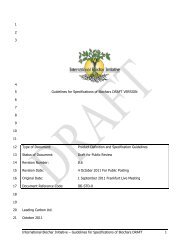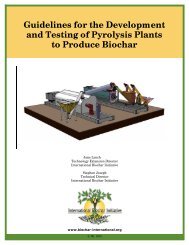Guidelines on Practical Aspects of Biochar Application to Field Soil ...
Guidelines on Practical Aspects of Biochar Application to Field Soil ...
Guidelines on Practical Aspects of Biochar Application to Field Soil ...
- No tags were found...
Create successful ePaper yourself
Turn your PDF publications into a flip-book with our unique Google optimized e-Paper software.
<str<strong>on</strong>g>Guidelines</str<strong>on</strong>g> <strong>on</strong> <strong>Practical</strong> <strong>Aspects</strong> <strong>of</strong><strong>Biochar</strong> Applicati<strong>on</strong> <strong>to</strong> <strong>Field</strong> <strong>Soil</strong> inVarious <strong>Soil</strong> Management SystemsPho<strong>to</strong> by Josiah HuntJulie Major , PhDExtensi<strong>on</strong> Direc<strong>to</strong>rInternati<strong>on</strong>al <strong>Biochar</strong> Initiativewww.biochar-internati<strong>on</strong>al.org© IBI, 2010
IBI would like <strong>to</strong> acknowledge c<strong>on</strong>tributi<strong>on</strong>s by Micah Woods(Asian Turfgrass Center), Kelby Fite (Bartlett Tree ResearchLabora<strong>to</strong>ries), Dan Pote (USDA-ARS), Christine Ziegler (RodaleInstitute), Tracy Miedema (Earthbound Farms), Annette Cowie(NSW-DPI), Philip Small (NSCSS), Alfred Gathorne-Hardy(Imperial College) and Erich Knight (EcoTechnologies Group).IBI and Julie Major are not resp<strong>on</strong>sible for any prejudice caused bythe applicati<strong>on</strong> <strong>of</strong> guidelines given in this manual.Document Versi<strong>on</strong> Informati<strong>on</strong>:Ver. 1.0, 9 November 2010
Table <strong>of</strong> C<strong>on</strong>tents1. Purpose ............................................................................................... 52. Introducti<strong>on</strong> ......................................................................................... 53. General c<strong>on</strong>siderati<strong>on</strong>s for biochar applicati<strong>on</strong> <strong>to</strong> soil .................................. 53.1 Characterizati<strong>on</strong> and testing <strong>of</strong> biochar materials ..................................... 53.2 Regulati<strong>on</strong>s pertinent <strong>to</strong> soil applicati<strong>on</strong> <strong>of</strong> biochar ................................... 63.3 Best management practices for biochar s<strong>to</strong>rage, handling,and transportati<strong>on</strong> .................................................................................... 63.4 Best management practices for biochar soil applicati<strong>on</strong> ............................. 73.4.1 Problem – wind loss .................................................................... 73.4.2 Best Management Practices <strong>to</strong> avoid wind loss ................................ 73.4.3 Problem – water erosi<strong>on</strong> .............................................................. 83.4.4 Best Management Practices <strong>to</strong> avoid erosi<strong>on</strong> by water ...................... 83.5 Size <strong>of</strong> biochar particles ....................................................................... 83.6 Applicati<strong>on</strong> rate ................................................................................... 83.7 Frequency <strong>of</strong> applicati<strong>on</strong> ..................................................................... 103.8 Formulated biochar products ............................................................... 103.9 Meeting standards for Organic agriculture ............................................. 114. <strong>Biochar</strong> applicati<strong>on</strong> <strong>to</strong> soil management systems ..................................... 124.1 C<strong>on</strong>venti<strong>on</strong>al field crop systems .......................................................... 124.1.1 Broadcast and incorporate .......................................................... 124.1.2 Traditi<strong>on</strong>al banding .................................................................... 134.1.3 Mixing biochar with other solid amendments ................................. 144.1.4 Mixing biochar with liquid manures .............................................. 144.1.5 Targeted biochar applicati<strong>on</strong>s in precisi<strong>on</strong> agriculture ..................... 144.2 Reduced and no-till systems, established pasture vegetati<strong>on</strong> ................... 144.2.1 Pesticide sorpti<strong>on</strong> and potential inactivati<strong>on</strong> by biochar ................... 144.2.2 Subsurface banding ................................................................... 144.2.3 Surface applicati<strong>on</strong> in perennial vegetati<strong>on</strong> ................................... 154.3 Horticultural crops ............................................................................. 154.4 Tree crops ........................................................................................ 16<str<strong>on</strong>g>Guidelines</str<strong>on</strong>g> for <strong>Biochar</strong> Applicati<strong>on</strong> <strong>to</strong> <strong>Soil</strong>—Internati<strong>on</strong>al <strong>Biochar</strong> Initiative Page 3
4.4.1 Surface applicati<strong>on</strong> .................................................................... 174.4.2 Localized applicati<strong>on</strong>s................................................................. 174.5 Landscaping, gardening and turfgrass .................................................. 184.5.1 Broadcast and uniform mixing with new <strong>to</strong>psoil applicati<strong>on</strong>s ............ 184.5.2 Localized applicati<strong>on</strong> .................................................................. 194.5.3 Applicati<strong>on</strong> in structural layers while c<strong>on</strong>structing golf greens .......... 194.5.4 Applicati<strong>on</strong> <strong>to</strong> turf aerati<strong>on</strong> holes ................................................. 194.6 Carb<strong>on</strong>-sequestering art work in the landscape ...................................... 195. C<strong>on</strong>clusi<strong>on</strong>s ........................................................................................ 196. Additi<strong>on</strong>al resources ............................................................................ 207. Literature cited ................................................................................... 20Page 4<str<strong>on</strong>g>Guidelines</str<strong>on</strong>g> for <strong>Biochar</strong> Applicati<strong>on</strong> <strong>to</strong> <strong>Soil</strong>—Internati<strong>on</strong>al <strong>Biochar</strong> Initiative
1. PurposeThis guide provides an overview <strong>of</strong> current biochar knowledge pertinent <strong>to</strong> its applicati<strong>on</strong> <strong>to</strong>soil, and gives ideas for using biochar in a variety <strong>of</strong> soil management systems. Very littledata is currently available <strong>on</strong> practical aspects <strong>of</strong> working with biochar, including laborrequirements, ec<strong>on</strong>omic feasibility and efficacy. This guide summarizes what is known s<strong>of</strong>ar and is intended as a practical guide for farmers and others engaged in biochar fieldtrials.2. Introducti<strong>on</strong>When it is added <strong>to</strong> soil, biochar has generally been shown <strong>to</strong> be beneficial for growingcrops; additi<strong>on</strong>ally biochar c<strong>on</strong>tains stable carb<strong>on</strong> (C) and after adding biochar <strong>to</strong> soil, thiscarb<strong>on</strong> remains sequestered for much l<strong>on</strong>ger periods than it would in the original biomassthat biochar was made from. Crop yield improvements with biochar have beendem<strong>on</strong>strated repeatedly for acidic and highly weathered tropical field soils (Lehmann etal., 2003; R<strong>on</strong>d<strong>on</strong> et al., 2007; Steiner et al., 2007; Kimetu et al., 2008), and there is newdata <strong>on</strong> biochar use in temperate soils <strong>of</strong> higher fertility (Laird, 2009; Husk and Major,2010). While many reports <strong>on</strong> biochar trials exist in the scientific literature, the practice <strong>of</strong>applying it <strong>to</strong> soil in commercial farm or other “real life” operati<strong>on</strong>s is just beginning, andno widely accepted guidelines currently exist.Although biochar is not <strong>of</strong>ficially recognized by any regula<strong>to</strong>ry regime or program as amethod for generating C <strong>of</strong>fsets, it holds promise because its mean residence time in soil isestimated <strong>to</strong> be in the scale <strong>of</strong> centuries <strong>to</strong> millennia (Cheng et al., 2008; Kuzyakov et al.,2009; Major et al., 2010a). In order <strong>to</strong> ensure that biochar management remains a carb<strong>on</strong>negative practice, special attenti<strong>on</strong> must be placed <strong>on</strong> minimizing the full lifecycle costs <strong>of</strong>handling and applying biochar at scale.3. General c<strong>on</strong>siderati<strong>on</strong>s for biochar applicati<strong>on</strong> <strong>to</strong>soil3.1 Characterizati<strong>on</strong> and testing <strong>of</strong> biochar materialsDetermining where and how <strong>to</strong> apply biochar begins with the characterizati<strong>on</strong> <strong>of</strong> thebiochar material. Characteristics <strong>of</strong> biochar materials will vary depending <strong>on</strong> what thebiochar is made from, and how it is made. Variati<strong>on</strong> in the pH, ash c<strong>on</strong>tent, surface area,and other characteristics <strong>of</strong> biochar is the basis for the c<strong>on</strong>cept <strong>of</strong> “designerbiochar” (Novak et al., 2009b), where the characteristics <strong>of</strong> a biochar are matched <strong>to</strong> thespecific needs <strong>of</strong> a soil and/or soil management system. For example, certain high-pHbiochars may be best for applying <strong>to</strong> acidic soils, while others with elevated c<strong>on</strong>tents <strong>of</strong>highly recalcitrant C (but which are amorphous in structure) might be better suited <strong>to</strong>situati<strong>on</strong>s where C sequestrati<strong>on</strong> is the main goal. To date, actual field data is lacking <strong>to</strong><str<strong>on</strong>g>Guidelines</str<strong>on</strong>g> for <strong>Biochar</strong> Applicati<strong>on</strong> <strong>to</strong> <strong>Soil</strong>—Internati<strong>on</strong>al <strong>Biochar</strong> Initiative Page 5
address which measurable characteristics <strong>of</strong> biochar are the most relevant <strong>to</strong> soilimprovement and soil C sequestrati<strong>on</strong>, in a range <strong>of</strong> soil envir<strong>on</strong>ments and managementsystems. There is a str<strong>on</strong>g need for a biochar characterizati<strong>on</strong> system, <strong>to</strong> allow testing <strong>of</strong>biochar products <strong>to</strong> ensure quality and effectiveness.Several groups, including the IBI, are currently working <strong>on</strong> determining whichcharacteristics should be measured in biochar materials, and <strong>on</strong> adapting analyticalmethods for carrying out the measurements. Users <strong>of</strong> biochar should be aware that biocharc<strong>on</strong>tains ash (mineral matter, including salts) and usually water. The amount <strong>of</strong> water inbiochar can be significant. Since biochar can hold a great deal <strong>of</strong> moisture, c<strong>on</strong>sumersshould enquire about moisture c<strong>on</strong>tent when purchasing biochar by weight. Ash canprovide plant nutrients but biochar with a high proporti<strong>on</strong> <strong>of</strong> ash, such as biochar madefrom animal manure, will c<strong>on</strong>tain a corresp<strong>on</strong>dingly lower amount <strong>of</strong> recalcitrant carb<strong>on</strong>.As the market for biochar evolves, makers <strong>of</strong> biochar products will be compelled <strong>to</strong>document and understand differences in these materials, and <strong>to</strong> work with farmers andgardeners <strong>to</strong> provide them with the most appropriate biochar for their c<strong>on</strong>diti<strong>on</strong>s.3.2 Regulati<strong>on</strong>s pertinent <strong>to</strong> soil applicati<strong>on</strong> <strong>of</strong> biocharDepending <strong>on</strong> the country, there may be different permits required for applying biochar <strong>to</strong>soil. For example, if biochar is applied with the objective <strong>of</strong> improving agricultural soil (asopposed <strong>to</strong>, for example, disposing <strong>of</strong> waste), permits are not likely <strong>to</strong> be required in theUSA, regardless <strong>of</strong> the scale <strong>of</strong> applicati<strong>on</strong>. The same applies for applicati<strong>on</strong> in urban andresidential landscaping settings. However, the definiti<strong>on</strong> <strong>of</strong> waste varies by jurisdicti<strong>on</strong>, andfor example in Ontario, Canada, a material which has g<strong>on</strong>e through a process such aspyrolysis or gasificati<strong>on</strong> is c<strong>on</strong>sidered a waste and must be treated as such. Regulati<strong>on</strong>srelevant <strong>to</strong> the use <strong>of</strong> biochar in soils may evolve or change as the industry develops, andpotential users should inform themselves and act in compliance with all relevant standardsand regulati<strong>on</strong>s pertinent <strong>to</strong> biochar in their locale.3.3 Best management practices for biochar s<strong>to</strong>rage, handling, andtransportati<strong>on</strong>As explained by Blackwell et al. (2009), biochar can represent a fire hazard. <strong>Biochar</strong> dustparticles can form explosive mixtures with air in c<strong>on</strong>fined spaces, and there is a danger <strong>of</strong>sp<strong>on</strong>taneous heating and igniti<strong>on</strong> when biochar is tightly packed. This occurs because freshbiochar quickly sorbs oxygen and moisture, and these sorpti<strong>on</strong> processes are exothermic,thus potentially leading <strong>to</strong> high temperature and igniti<strong>on</strong> <strong>of</strong> the material. The volatilecompounds present in certain biochar materials may also represent a fire hazard, but theamount <strong>of</strong> such compounds found in biochar can be managed by managing the pyrolysistemperature and heating rate (Antal and Gr<strong>on</strong>li, 2003). Certain chemicals can be added <strong>to</strong>biochar <strong>to</strong> decrease its flammability (e.g. boric acid, ferrous sulfate) (Blackwell et al.,2009). Water can also reduce flammability, although its effectiveness is not known unlessPage 6<str<strong>on</strong>g>Guidelines</str<strong>on</strong>g> for <strong>Biochar</strong> Applicati<strong>on</strong> <strong>to</strong> <strong>Soil</strong>—Internati<strong>on</strong>al <strong>Biochar</strong> Initiative
the biochar is saturated and it also increases the weight <strong>of</strong> the material and thus shippingcosts. The best way <strong>to</strong> prevent fire is <strong>to</strong> s<strong>to</strong>re and transport biochar in an atmospherewhich excludes oxygen (Blackwell et al., 2009). Rules for the transport <strong>of</strong> charcoal existunder many jurisdicti<strong>on</strong>s. Formulated biochar products such as mixtures with composts,manures, or the producti<strong>on</strong> <strong>of</strong> biochar-mineral complexes will potentially yield productswhich are much less flammable.3.4 Best management practices for biochar soil applicati<strong>on</strong>The particle size distributi<strong>on</strong> <strong>of</strong> biochar materials will vary widely depending <strong>on</strong> thefeeds<strong>to</strong>ck and the pyrolysis technique used <strong>to</strong> produce the biochar. Still, most biocharmaterials will c<strong>on</strong>tain small particles, as biochar is brittle and small particles are formedwhen the material is handled.3.4.1 Problem – wind lossWith small particles, it is important <strong>to</strong> apply biochar in ways that minimize loss due <strong>to</strong> windor water erosi<strong>on</strong>. If large amounts <strong>of</strong> fine biochar dust are lost during the applicati<strong>on</strong> andincorporati<strong>on</strong> <strong>of</strong> biochar <strong>to</strong> soil, documenting the actual applicati<strong>on</strong> rate <strong>of</strong> the materialbecomes complicated, and such losses are obviously undesirable if biochar represents avaluable amendment. This problem was encountered by Blue Leaf Inc. during theestablishment <strong>of</strong> a biochar field trial in Québec, Canada in 2008. Blue Leaf applied a finegrained biochar produced by fast pyrolysis, and estimated that 2% <strong>of</strong> the material was lostwhile loading the spreader (a lime spreader was used), 3% was lost during transport <strong>to</strong> theapplicati<strong>on</strong> area, and 25% was lost during spreading, for a <strong>to</strong>tal loss <strong>of</strong> approximately30%.A best management practice <strong>to</strong> greatly reduce such wind losses is <strong>to</strong> moisten biochar,however adding water increases the weight <strong>of</strong> the material and this can increase transportcosts. While water is usually added <strong>to</strong> biochar immediately after exiting the pyrolysis unitin order <strong>to</strong> quench it, more water could be applied <strong>to</strong> reduce dustiness prior <strong>to</strong> fieldapplicati<strong>on</strong>. Moisture c<strong>on</strong>tent must always be taken in<strong>to</strong> c<strong>on</strong>siderati<strong>on</strong> when determiningapplicati<strong>on</strong> rate, whether or not the end user adds water themselves. <strong>Biochar</strong> that isseemingly dry can c<strong>on</strong>tain a high percentage <strong>of</strong> moisture, and applicati<strong>on</strong> rates can beoverestimated.3.4.2 Best Management Practices <strong>to</strong> avoid wind loss1. Apply biochar under the right weather c<strong>on</strong>diti<strong>on</strong>s when winds are mild. Windvaries according <strong>to</strong> general weather c<strong>on</strong>diti<strong>on</strong>s and time <strong>of</strong> day. It may also behelpful <strong>to</strong> apply biochar during mild rain c<strong>on</strong>diti<strong>on</strong>s where light rain will dampenbiochar dust and hold it <strong>on</strong> the soil surface until it can be tilled in.2. Apply moisture <strong>to</strong> biochar. Water can be applied directly <strong>to</strong> the biochar, or it canbe mixed with moist manure, for example.3. Produce a biochar formulati<strong>on</strong> by pelleting, prilling, and mixing biochar with<str<strong>on</strong>g>Guidelines</str<strong>on</strong>g> for <strong>Biochar</strong> Applicati<strong>on</strong> <strong>to</strong> <strong>Soil</strong>—Internati<strong>on</strong>al <strong>Biochar</strong> Initiative Page 7
other types <strong>of</strong> amendments such as manures or composts. Different biocharformulati<strong>on</strong>s will be best suited <strong>to</strong> different applicati<strong>on</strong> methods, and very finebiochar may be desirable in certain cases, for example when applying as aslurry, by itself or mixed with manure (Blackwell et al., 2009). Research <strong>on</strong>formulating biochar for handling and applicati<strong>on</strong> is underway, but results <strong>of</strong> suchwork are not yet widely available.3.4.3 Problem – water erosi<strong>on</strong>In additi<strong>on</strong> <strong>to</strong> loss by wind during/after applicati<strong>on</strong>, biochar can also be lost by watererosi<strong>on</strong>. As for soil erosi<strong>on</strong> itself, sloping terrain aggravates this problem. Rumpel et al.(2006) found that surface-deposited biochar was eroded from steep slopes in Laos,emphasizing the need for soil incorporati<strong>on</strong>—especially when biochar is applied <strong>to</strong> slopingterrain. Major et al. (2010a) also observed significant losses <strong>of</strong> biochar incorporated in<strong>to</strong>practically flat terrain, in an area where intense rainfall events occur. <strong>Biochar</strong> can requiresome time for wetting so<strong>on</strong> after applicati<strong>on</strong>, and may float away when a thick layer <strong>of</strong>standing water pools over the soil and moves <strong>to</strong>wards the bot<strong>to</strong>m <strong>of</strong> the site’s slope.3.4.4 Best Management Practices <strong>to</strong> avoid erosi<strong>on</strong> by waterA best management practice <strong>to</strong> address this problem is <strong>to</strong> properly incorporate biochar in<strong>to</strong>soil, especially <strong>on</strong> sloping terrain or where very intense rainfall events occur. The methodused for biochar incorporati<strong>on</strong> must itself be chosen <strong>to</strong> minimize erosi<strong>on</strong> losses. Secti<strong>on</strong> 4<strong>of</strong> this document presents a variety <strong>of</strong> methods for achieving these best practices.3.5 Size <strong>of</strong> biochar particlesWhat is the optimum size range for biochar particles? L<strong>on</strong>g-term studies in different soilsare required <strong>to</strong> draw str<strong>on</strong>g c<strong>on</strong>clusi<strong>on</strong>s regarding the effect <strong>of</strong> the size <strong>of</strong> biochar particles<strong>on</strong> soil improvement and C sequestrati<strong>on</strong>. Ideal particle sizes <strong>to</strong> improve soil moistureretenti<strong>on</strong> have not been determined. It is expected that practical c<strong>on</strong>siderati<strong>on</strong>s related <strong>to</strong>handling and applying the biochar will also impact the decisi<strong>on</strong> <strong>of</strong> what particle size is best.<strong>Biochar</strong> can be finely divided and can be applied <strong>to</strong> soil as-is, provided care is taken <strong>to</strong>minimize wind losses. If particle size must be reduced (for example from biochar madefrom old pallets or larger pieces <strong>of</strong> wood), it can be hand crushed inside bags using a largepestle. Small amounts can also be crushed by driving over the material with a roller pulledby a trac<strong>to</strong>r. For crushing larger amounts <strong>of</strong> biochar materials, hammer mills can be used,as well as compost shredders, for example. Best management practices include moisteningthe material before crushing it <strong>to</strong> reduce dust created during the process, and/or crushingthe biochar inside closed bags.3.6 Applicati<strong>on</strong> rateRecommended applicati<strong>on</strong> rates for any soil amendment must be based <strong>on</strong> extensive fieldtesting. At this time, insufficient field data is available <strong>to</strong> make general recommendati<strong>on</strong>sPage 8<str<strong>on</strong>g>Guidelines</str<strong>on</strong>g> for <strong>Biochar</strong> Applicati<strong>on</strong> <strong>to</strong> <strong>Soil</strong>—Internati<strong>on</strong>al <strong>Biochar</strong> Initiative
Figure 1. Left: Hand crushing biochar inside sacks in H<strong>on</strong>duras. Pho<strong>to</strong> by J. Major. Right: Crushingmoistened biochar using a small compost shredder in Oreg<strong>on</strong>, USA. Pho<strong>to</strong> by D. Dalegowski.<strong>on</strong> biochar applicati<strong>on</strong> rates according <strong>to</strong> soil types and crops. Also, biochar materials candiffer widely in their characteristics, thus the nature <strong>of</strong> a specific biochar material (e.g. pH,ash c<strong>on</strong>tent) also influences applicati<strong>on</strong> rate. In the published literature, several studieshave reported positive effects <strong>of</strong> biochar applicati<strong>on</strong> <strong>on</strong> crop yields with rates <strong>of</strong> 5-50t<strong>on</strong>nes <strong>of</strong> biochar per hectare, with appropriate nutrient management. This is a largerange, but <strong>of</strong>ten when several rates are used, the plots with the higher biochar applicati<strong>on</strong>rate show better results (Chan et al., 2007, 2008; Major et al., 2010b). Since the Cc<strong>on</strong>tent <strong>of</strong> biochar materials varies, it may be appropriate <strong>to</strong> report applicati<strong>on</strong> rates int<strong>on</strong>nes <strong>of</strong> biochar-C per hectare, as opposed <strong>to</strong> t<strong>on</strong>nes <strong>of</strong> bulk biochar material. A 10 t/haapplicati<strong>on</strong> <strong>of</strong> poultry manure biochar c<strong>on</strong>tains much less C (and more ash) than anequivalent applicati<strong>on</strong> <strong>of</strong> wood waste biochar. However, “high-ash” biochar can c<strong>on</strong>stitute asource <strong>of</strong> various plant nutrients, and these should be taken in<strong>to</strong> c<strong>on</strong>siderati<strong>on</strong> whenmanaging soil fertility at the field level.Most biochar materials are not substitutes for fertilizer, so adding biochar withoutnecessary amounts <strong>of</strong> nitrogen (N) and other nutrients cannot be expected <strong>to</strong> provideimprovements <strong>to</strong> crop yield. Instances <strong>of</strong> decreasing yield due <strong>to</strong> a high biochar applicati<strong>on</strong>rate were reported when the equivalent <strong>of</strong> 165 t <strong>of</strong> biochar/ha was added <strong>to</strong> a poor soil ina pot experiment (R<strong>on</strong>d<strong>on</strong> et al., 2007). At this high applicati<strong>on</strong> rate, yields decreased <strong>to</strong>the level <strong>of</strong> the unamended c<strong>on</strong>trol. This is a very large amount that is unlikely <strong>to</strong> bepractically feasible in the field, at least for a <strong>on</strong>e-time amendment. However, Asai et al.(2009) working in Laos reported greater upland rice yields with 4 t/ha biochar, but when 8or 16 t/ha were applied, yields were not different from the unamended c<strong>on</strong>trol. A morerecent field study <strong>on</strong> a poor, acidic soil <strong>of</strong> the USA showed that peanut hull and pine chipbiochar applied at 11 and 22 t/ha could reduce corn yields below those obtained in thec<strong>on</strong>trol plots, under standard fertilizer management (Gaskin et al., 2010). The reas<strong>on</strong>s for<str<strong>on</strong>g>Guidelines</str<strong>on</strong>g> for <strong>Biochar</strong> Applicati<strong>on</strong> <strong>to</strong> <strong>Soil</strong>—Internati<strong>on</strong>al <strong>Biochar</strong> Initiative Page 9
such a decrease remain <strong>to</strong> be fully explored and must be unders<strong>to</strong>od in order <strong>to</strong> determinewhich biochar material are best suited for applicati<strong>on</strong>, and at which rates, <strong>to</strong> specific soilsin specific soil management systems.3.7 Frequency <strong>of</strong> applicati<strong>on</strong>Due <strong>to</strong> its recalcitrance <strong>to</strong> decompositi<strong>on</strong> in soil, single applicati<strong>on</strong>s <strong>of</strong> biochar can providebeneficial effects over several growing seas<strong>on</strong>s in the field (Steiner et al., 2007; Major etal., 2010b). Therefore, biochar does not need <strong>to</strong> be applied with each crop, as is usuallythe case for manures, compost, and synthetic fertilizers. Depending <strong>on</strong> the targetapplicati<strong>on</strong> rate, the availability <strong>of</strong> the biochar supply, and the soil management system,biochar amendments can be applied in increments. However, it is believed that beneficialeffects <strong>of</strong> applying biochar <strong>to</strong> soil improve with time, and this may need <strong>to</strong> be taken in<strong>to</strong>c<strong>on</strong>siderati<strong>on</strong> when splitting applicati<strong>on</strong>s over time.3.8 Formulated biochar productsSince biochar itself cannot be c<strong>on</strong>sidered a source <strong>of</strong> nutrients (unless it has a high ashc<strong>on</strong>tent), there is interest in blending it with other materials such as synthetic fertilizers,compost and manures <strong>to</strong> enhance its value as a soil amendment. Furthermore, biochar hasbeen shown <strong>to</strong> retain nutrients against leaching (Major et al., 2009; Novak et al., 2009a),potentially improving the efficiency <strong>of</strong> nutrients applied al<strong>on</strong>gside biochar.Adding biochar <strong>to</strong> sewage sludge or poultry manure during composting has been shown <strong>to</strong>reduce N losses (Dias et al., 2009; Hua et al., 2009) and the mobility <strong>of</strong> some heavymetals was also reduced in sewage sludge compost with biochar (Hua et al., 2009). Diaset al. (2009) compared biochar <strong>to</strong> other bulking agents for compost making, and foundthat adding biochar resulted in greater humificati<strong>on</strong> or “maturity” <strong>of</strong> the compost at theend <strong>of</strong> the study period. It is also believed that adding biochar <strong>to</strong> composts and manurescan reduce odors.Figure 2. Applying biochar-amendedcompost <strong>to</strong> planting beds in Hawaii.Pho<strong>to</strong> by J. Hunt.Page 10<str<strong>on</strong>g>Guidelines</str<strong>on</strong>g> for <strong>Biochar</strong> Applicati<strong>on</strong> <strong>to</strong> <strong>Soil</strong>—Internati<strong>on</strong>al <strong>Biochar</strong> Initiative
Dr Mako<strong>to</strong> Ogawa <strong>of</strong> the Osaka Institute <strong>of</strong> Technology in Japan states that: “Makingcompost from litter and excreti<strong>on</strong>s has been comm<strong>on</strong> in Japan for a l<strong>on</strong>g time. In the1980s, charcoal compost was made from fresh chicken dung and palm shell charcoal; themore charcoal used, the faster the composting process. Under aerobic c<strong>on</strong>diti<strong>on</strong>s theBacillus group became dominant and produced antibiotics that inhibited growth <strong>of</strong> soilbornepathogens and suppressed root diseases. Charcoal compost is now sold in Japan asa biological fungicide. Various other organic composts are now being been produced fromlives<strong>to</strong>ck excreti<strong>on</strong>s and charcoal and sold commercially.” (Ogawa, 2009).Another example from Japan is bokashi, an organic fertilizer made by combining “effective”microbes, molasses, biochar, bran, and animal manure with water, and incubating underanaerobic or partially anaerobic c<strong>on</strong>diti<strong>on</strong>s (there are variati<strong>on</strong>s <strong>of</strong> this recipe and some d<strong>on</strong>ot include charcoal). This amendment was developed by the Japanese philosopher MokichiOkada in 1935 (Reap Canada), and is now made and used in many developing countriesaround the world, <strong>of</strong>ten incorporating native micro-organisms in additi<strong>on</strong> <strong>to</strong> the “effective”micro-organisms. The biochar can be made from any c<strong>on</strong>venient source <strong>of</strong> biomass, suchas sugar cane bagasse.Rice hull biochar is <strong>of</strong>ten used due <strong>to</strong> the availability <strong>of</strong> rice hulls in many regi<strong>on</strong>s.However, great care must be exercised while carb<strong>on</strong>izing rice hulls, as high processtemperatures can lead <strong>to</strong> the producti<strong>on</strong> <strong>of</strong> carcinogenic compounds. Rice hullcarb<strong>on</strong>izati<strong>on</strong> is routinely d<strong>on</strong>e <strong>on</strong> a variety <strong>of</strong> scales throughout the world, and processtemperature is very <strong>of</strong>ten unc<strong>on</strong>trolled, resulting in a potential health hazard. For moreinformati<strong>on</strong> <strong>on</strong> testing the safety <strong>of</strong> pyrolysis units, refer <strong>to</strong> IBI <str<strong>on</strong>g>Guidelines</str<strong>on</strong>g> for theDevelopment and Testing <strong>of</strong> Pyrolysis Plants, available <strong>on</strong> the IBI website.3.9 Meeting standards for Organic agricultureThe Nati<strong>on</strong>al Organic Program <strong>of</strong> the United States Department <strong>of</strong> Agriculture states thatbiochar is c<strong>on</strong>sidered a “n<strong>on</strong>-synthetic allowed” material, so l<strong>on</strong>g as it is made from plantbiomass and not animal manures, since ash from manure is prohibited. The use <strong>of</strong> “woodash” is also restricted for use <strong>on</strong> certified organic land by certain programs in the USA(Nati<strong>on</strong>al Sustainable Agriculture Informati<strong>on</strong> Service). AsureQuality <strong>of</strong> New Zealand lists“wood charcoal” and “wood ash” as requiring approval before use in certified organicagriculture (AsureQuality, 2010). In the province <strong>of</strong> Québec, Canada, the C<strong>on</strong>seil desappellati<strong>on</strong>s réservées et des termes valorisants (Council <strong>on</strong> reserved designati<strong>on</strong>s andvalue-added terms, which regulates organic certificati<strong>on</strong> agencies operating in theprovince) approves <strong>of</strong> wood charcoal as an amendment in organic agriculture.It is expected that with the rise <strong>of</strong> interest in and availability <strong>of</strong> biochar individualcertificati<strong>on</strong> agencies will start regulating biochar as a soil amendment in organicagriculture. Farmers should check with their certifying agency before using biochar. It isforeseeable that individual biochar products will require organic certificati<strong>on</strong>, given thelarge variability in biochar feeds<strong>to</strong>cks and characteristics.<str<strong>on</strong>g>Guidelines</str<strong>on</strong>g> for <strong>Biochar</strong> Applicati<strong>on</strong> <strong>to</strong> <strong>Soil</strong>—Internati<strong>on</strong>al <strong>Biochar</strong> Initiative Page 11
4. <strong>Biochar</strong> applicati<strong>on</strong> <strong>to</strong> soil management systemsWhen applying biochar <strong>to</strong> soil for improving its fertility, the biochar should ideally belocated near the soil’s surface in the root z<strong>on</strong>e, where the bulk <strong>of</strong> nutrient cycling anduptake by plants takes place. Certain systems may benefit from the applicati<strong>on</strong> <strong>of</strong> biocharin layers below the root z<strong>on</strong>e, for example during landscaping for C sequestrati<strong>on</strong> or ifusing biochar for moisture management. Similarly, if biochar were <strong>to</strong> be applied <strong>to</strong> soilsolely for C sequestrati<strong>on</strong> purposes, placement deeper in the soil, for example in newlandscaping or c<strong>on</strong>structi<strong>on</strong> areas, would be desired since microbial activity that candegrade biochar carb<strong>on</strong> is reduced deeper in the soil pr<strong>of</strong>ile.When deciding how <strong>to</strong> apply biochar <strong>to</strong> soil, the specific cropping system must be takenin<strong>to</strong> c<strong>on</strong>siderati<strong>on</strong>. The likelihood <strong>of</strong> wind and water erosi<strong>on</strong> losses <strong>of</strong> biochar is reducedwhen biochar is thoroughly incorporated in<strong>to</strong> soil, however, plowing and soil mixing are notpossible or desirable in all cropping systems, at all times.4.1 C<strong>on</strong>venti<strong>on</strong>al field crop systemsIn c<strong>on</strong>venti<strong>on</strong>al field cropping systems, biochar should ideally be managed using traditi<strong>on</strong>alfarm machinery and incorporated in<strong>to</strong> routine field operati<strong>on</strong>s. This will ensure that thecosts <strong>of</strong> using biochar are kept as low as possible. For example, biochar can be applied andincorporated <strong>to</strong>gether with lime, since lime is <strong>of</strong>ten applied as a fine solid which must bewell incorporated in<strong>to</strong> soil.4.1.1 Broadcast and incorporateThe majority <strong>of</strong> biochar field trials reported <strong>to</strong> date used this method for incorporatingbiochar in<strong>to</strong> soil (Yama<strong>to</strong> et al., 2006; Steiner et al., 2007; Asai et al., 2009; Major et al.,2010b). Broadcasting can be d<strong>on</strong>e by hand <strong>on</strong> small scales, or <strong>on</strong> larger scales by usinglime/solid manure spreaders or broadcast seeders. Moistened biochar materials may beFigure 3. Broadcasting and incorporatingbiochar by hand in H<strong>on</strong>duras. Pho<strong>to</strong> by J.Major.Page 12<str<strong>on</strong>g>Guidelines</str<strong>on</strong>g> for <strong>Biochar</strong> Applicati<strong>on</strong> <strong>to</strong> <strong>Soil</strong>—Internati<strong>on</strong>al <strong>Biochar</strong> Initiative
etter suited <strong>to</strong> applicati<strong>on</strong> with manure spreaders than lime spreaders. Incorporati<strong>on</strong> canbe achieved using any plowing method at any scale, including hand hoes, animal draftplows, disc harrows, chisels, rotary hoes, etc. Moldboard plowing is not recommended as itis unlikely <strong>to</strong> mix the biochar in<strong>to</strong> the soil and may result in deep biochar layers (Blackwellet al., 2009). As menti<strong>on</strong>ed above, wind losses from applying and incorporating finebiochar materials can be significant (see Fig 4) and precauti<strong>on</strong>s must be taken <strong>to</strong> minimizethis.Figure 4. Clockwise from<strong>to</strong>p left: <strong>Biochar</strong> lossesduring handling,transportati<strong>on</strong> <strong>to</strong> the field,applicati<strong>on</strong> with a limespreader and incorporati<strong>on</strong>with a disc harrow duringthe establishment <strong>of</strong> abiochar field trial in St-Francois-Xavier-de-Brompt<strong>on</strong>, QC Canada.Pho<strong>to</strong>s by B. Husk.4.1.2 Traditi<strong>on</strong>al bandingBanding <strong>of</strong> seeds and fertilizers is a routine operati<strong>on</strong> in mechanized agriculture, andinvolves applying an amendment in a narrow band, usually using equipment that cuts thesoil open, without disturbing the entire soil surface. Banding allows biochar <strong>to</strong> be placedinside the soil while minimizing soil disturbance, making it possible <strong>to</strong> apply biochar aftercrop establishment, for example. However, the amounts <strong>of</strong> biochar that can be applied inthis way are lower than those which can be achieved by broadcast applicati<strong>on</strong>s. WheatFigure 5. Deep banding biochar in Australia. Pho<strong>to</strong> by P.Blackwell.<str<strong>on</strong>g>Guidelines</str<strong>on</strong>g> for <strong>Biochar</strong> Applicati<strong>on</strong> <strong>to</strong> <strong>Soil</strong>—Internati<strong>on</strong>al <strong>Biochar</strong> Initiative Page 13
yields in Western Australia were improved by banding biochar (Blackwell et al., 2007).When working by hand, biochar can be applied in furrows opened using a hoe and closedafter applying biochar.4.1.3 Mixing biochar with other solid amendmentsMixing biochar with other soil amendments such as manure, compost or lime before soilapplicati<strong>on</strong> can improve efficiency by reducing the number <strong>of</strong> field operati<strong>on</strong>s required.Since biochar has been shown <strong>to</strong> sorb nutrients and protect them against leaching (Major,2009; Major et al., 2009; Novak et al., 2009a), mixing with biochar may improve theefficiency <strong>of</strong> manure or other amendment applicati<strong>on</strong>.4.1.4 Mixing biochar with liquid manures<strong>Biochar</strong> can also be mixed with liquid manures and applied as a slurry. Fine biochars willlikely be best suited <strong>to</strong> this type <strong>of</strong> applicati<strong>on</strong> using existing applicati<strong>on</strong> equipment, anddust problems associated with these would be addressed. <strong>Biochar</strong> could also be mixed withmanure in holding p<strong>on</strong>ds and could potentially reduce gaseous nitrogen losses as it doeswhen applied <strong>to</strong> soil (R<strong>on</strong>d<strong>on</strong> et al., 2005; Yanai et al., 2007; Spokas et al., 2009).4.1.5 Targeted biochar applicati<strong>on</strong>s in precisi<strong>on</strong> agricultureWhere high-resoluti<strong>on</strong> data <strong>on</strong> soil characteristics and farm machinery equipped withgeographical positi<strong>on</strong>ing systems are available, it would possible <strong>to</strong> apply biocharpreferentially <strong>to</strong> areas <strong>of</strong> fields where fertility is low.4.2 Reduced and no-till systems, established pasture vegetati<strong>on</strong>4.2.1 Relevant Issue: Pesticide sorpti<strong>on</strong> and potential inactivati<strong>on</strong> bybiochar<strong>Biochar</strong> is a precursor <strong>to</strong> activated carb<strong>on</strong>, a widely used sorbent for a variety <strong>of</strong>compounds. <strong>Biochar</strong> has been shown <strong>to</strong> sorb herbicides (Yamane and Green, 1972; Cao etal., 2009; Spokas et al., 2009; Wang et al., 2010), heavy metals (Mohan et al., 2007; Caoet al., 2009), and decrease crop uptake <strong>of</strong> insecticides (Yu et al., 2009). Whether specificmolecules sorbed by biochar are biodegraded or remain bio-available must be determined,but several practical advantages could result from biochar sorpti<strong>on</strong>, for example theprotecti<strong>on</strong> <strong>of</strong> crop seeds from soil-applied herbicides, and the productive use <strong>of</strong>c<strong>on</strong>taminated soils. Disadvantages could also exist, such as the inactivati<strong>on</strong> <strong>of</strong> herbicideswhich carry out their functi<strong>on</strong> in the soil.4.2.2 Subsurface bandingSistani et al. (2009) applied 9 t/ha <strong>of</strong> poultry manure <strong>to</strong> a perennial grassland bysubsurface banding using pro<strong>to</strong>type equipment, and observed large reducti<strong>on</strong>s in <strong>to</strong>talsuspended solids running <strong>of</strong>f from the soil’s surface after simulated rain events. Subsurfacebanding <strong>of</strong> dry material is a new technique, and farm machinery <strong>to</strong> achieve this is not yetcommercially available. Its developers are interested in solving problems <strong>of</strong> surface run<strong>of</strong>fand odor when applying poultry manure <strong>to</strong> soil, but have also used the equipment <strong>to</strong> applyPage 14<str<strong>on</strong>g>Guidelines</str<strong>on</strong>g> for <strong>Biochar</strong> Applicati<strong>on</strong> <strong>to</strong> <strong>Soil</strong>—Internati<strong>on</strong>al <strong>Biochar</strong> Initiative
iochar <strong>to</strong> soil. Subsurface banding could greatly reduce potential wind and water erosi<strong>on</strong>losses <strong>of</strong> biochar, and may be ideal <strong>on</strong> slopes, or when using very fine biochar materials.The equipment crushes large pieces <strong>of</strong> litter or biochar, and the material is then gravity fedin<strong>to</strong> trenches opened by discs, and the trenches are later closed with wheels that cover thematerial with soil. The equipment functi<strong>on</strong>s similarly <strong>to</strong> no-till planters, but a significantdifference is that the spreader crushes dry material before banding it (D. Pote, USDA-ARS,pers. comm.). Liquid slurries c<strong>on</strong>taining biochar could also be injected below the soil’ssurface.Figure 6. Left: USDA’s Agricultural Research Service dem<strong>on</strong>strates a pro<strong>to</strong>type poultry litter subsurfer inArkansas. The subsurfer is designed <strong>to</strong> apply litter under the surface <strong>of</strong> perennial pasture and other no-tillsystems, and gives farmers precise c<strong>on</strong>trol <strong>of</strong> litter applicati<strong>on</strong> rates. Right: Subsurfer leaves a “clean” soilsurface after applicati<strong>on</strong>. Pho<strong>to</strong>s by Stephanie Jordan.4.2.3 Surface applicati<strong>on</strong> in perennial vegetati<strong>on</strong><strong>Biochar</strong> can be <strong>to</strong>p dressed <strong>on</strong> perennial pastures or other perennial vegetati<strong>on</strong>, such asspaces between fruit trees in orchards. This type <strong>of</strong> applicati<strong>on</strong> makes amendments subject<strong>to</strong> losses, but it is routinely used <strong>to</strong> apply manures, compost, and synthetic fertilizer <strong>to</strong>res<strong>to</strong>re fertility in perennial systems. Surface applicati<strong>on</strong> <strong>of</strong> biochar <strong>to</strong> perennial pasturehas been d<strong>on</strong>e successfully in England (Gathorne-Hardy et al., 2008) without any visualobservati<strong>on</strong> <strong>of</strong> significant losses <strong>of</strong> biochar, and with observati<strong>on</strong> <strong>of</strong> incorporati<strong>on</strong> <strong>of</strong>biochar in<strong>to</strong> the soil by earthworms (A. Gathorne-Hardy, pers. comm.). However, data <strong>on</strong>biochar movement with surface applicati<strong>on</strong> <strong>to</strong> perennial vegetati<strong>on</strong> is lacking.4.3 Horticultural cropsApart from applicati<strong>on</strong> methods listed above for field crops, biochar could be applied withindividual plants while transplanting in the field, or mixed with <strong>to</strong>psoil and otheramendments while preparing raised beds. See the example <strong>of</strong> taro, in Fig. 8, below.<str<strong>on</strong>g>Guidelines</str<strong>on</strong>g> for <strong>Biochar</strong> Applicati<strong>on</strong> <strong>to</strong> <strong>Soil</strong>—Internati<strong>on</strong>al <strong>Biochar</strong> Initiative Page 15
Figure 7. Top-dressed biochar <strong>on</strong>perennial pasture in England, visible asdarker treated square plots. Pho<strong>to</strong> by A.Gathorne-Hardy)Figure 8. Taro plant transplanted withbiochar in Hawaii. Taro is grown underwaterlogged c<strong>on</strong>diti<strong>on</strong>s. Pho<strong>to</strong> by J.Hunt.4.4 Tree crops<strong>Biochar</strong> should ideally be applied <strong>to</strong> an area <strong>of</strong> soil that tree roots will eventually utilize <strong>to</strong>take up nutrients, i.e. the “drip line”. The drip line refers <strong>to</strong> the area you would get, <strong>on</strong>cethe tree has reached its mature size, if you drew a circle <strong>on</strong> the soil corresp<strong>on</strong>ding <strong>to</strong> thesize <strong>of</strong> the tree’s crown. To apply biochar <strong>to</strong> the entire drip line it is necessary <strong>to</strong> work itFigure 9. <strong>Biochar</strong> applied at transplanting oil palms in Costa Rica. Pho<strong>to</strong>s by T. Benjamin.Page 16<str<strong>on</strong>g>Guidelines</str<strong>on</strong>g> for <strong>Biochar</strong> Applicati<strong>on</strong> <strong>to</strong> <strong>Soil</strong>—Internati<strong>on</strong>al <strong>Biochar</strong> Initiative
in<strong>to</strong> the soil bey<strong>on</strong>d the tree’s planting hole, and this is not always possible. Here wedescribe different ways <strong>of</strong> applying biochar when establishing trees.4.4.1 Surface applicati<strong>on</strong>For tree establishment, it may be possible <strong>to</strong> broadcast and incorporate or band applybiochar over the entire planting area, and add more biochar in planting holes. Before orafter tree establishment, biochar could also be applied by traditi<strong>on</strong>al and subsurfacebanding or <strong>to</strong>p-dressed over perennial vegetati<strong>on</strong> in orchards, but care should be taken <strong>to</strong>minimize root damage and soil compacti<strong>on</strong>. More data <strong>on</strong> appropriate applicati<strong>on</strong> rates forplanting area treatment and planning hole applicati<strong>on</strong> are needed, but this technique hasbeen used <strong>to</strong> study biochar effects <strong>on</strong> the growth <strong>of</strong> oil palm in Colombia (D. Molina,Cenipalma, pers. comm.) and Costa Rica.4.4.2 Localized applicati<strong>on</strong>sNursery seedlings grown in biochar c<strong>on</strong>taining medium and transplanted in the field couldbenefit from biochar early <strong>on</strong>, but roots will usually grow outside the biochar amendedarea. Alternatively, if the soil outside the transplant medium is very inhospitable for plantroots (for example <strong>of</strong> very high or low pH), roots can seek <strong>to</strong> restrict themselves <strong>to</strong> thetransplant medium, resulting in unstable trees with poor root structures. <strong>Biochar</strong> can beapplied in trenches radiating out from the base <strong>of</strong> established trees (“radial trenching”) orin holes dug at some distance from the base <strong>of</strong> the tree (“vertical mulching”); biocharcould also potentially be applied <strong>to</strong> soil using “air excavati<strong>on</strong> <strong>to</strong>ols”. These <strong>to</strong>ols usepressurized air <strong>to</strong> deliver compost under the soil surface and reduce compacti<strong>on</strong>.Alternatively, the soil around tree roots can be excavated and biochar applied beforecovering with soil. This treatment has been shown <strong>to</strong> benefit valuable old trees in Japan(Japan <strong>Biochar</strong> Associati<strong>on</strong>).Figure 10. <strong>Biochar</strong> applied intrenches <strong>to</strong> established treesin Japan. Pho<strong>to</strong> by Sugiura.<str<strong>on</strong>g>Guidelines</str<strong>on</strong>g> for <strong>Biochar</strong> Applicati<strong>on</strong> <strong>to</strong> <strong>Soil</strong>—Internati<strong>on</strong>al <strong>Biochar</strong> Initiative Page 17
4.5 Landscaping, gardening and turfgrassLandscaping, gardening, and turfgrass establishment are activities which can take place inthe public sphere and can be used <strong>to</strong> highlight the benefits <strong>of</strong> biochar applicati<strong>on</strong>.Increased awareness <strong>of</strong> biochar technology am<strong>on</strong>g the public could improve theacceptability <strong>of</strong> biochar as a landscaping and gardening amendment, and even drive thedemand for its use in such settings, if c<strong>on</strong>sumers understand and value its benefits.When soil is removed for c<strong>on</strong>structi<strong>on</strong> and landscaping, there are opportunities <strong>to</strong> lay downthick layers <strong>of</strong> biochar under the rooting z<strong>on</strong>e <strong>of</strong> plants or under buildings or roads. Suchuses would not necessarily entail reaping soil enhancement benefits from biochar, butmight be valuable <strong>to</strong>ols if rapid C sequestrati<strong>on</strong> is desired. In the case <strong>of</strong> turfgrass, biocharcould help <strong>to</strong> improve moisture retenti<strong>on</strong> in greens. The acceptance <strong>of</strong> new golf courses bycitizens may be improved if biochar is used during their establishment, since additi<strong>on</strong>ally <strong>to</strong>C sequestrati<strong>on</strong>, biochar has the potential <strong>to</strong> reduce water requirements by increasingwater holding capacity (Try<strong>on</strong>, 1948; Chan et al., 2007; Novak et al., 2009b) and alsodecrease fertilizer use (Van Zwieten et al., 2009), as well as reduce polluti<strong>on</strong> from fertilizerand pesticide applicati<strong>on</strong>. These characteristics combined with the low density <strong>of</strong> biocharand its ability <strong>to</strong> reduce nutrient leaching also make it a desirable substrate for use ingreen ro<strong>of</strong>s.Figure 11. Trials <strong>of</strong> biochar mixed in<strong>to</strong>turfgrass substrate. Pho<strong>to</strong> by M. Woods.4.5.1 Broadcast and uniform mixing with new <strong>to</strong>psoil applicati<strong>on</strong>s<strong>Biochar</strong> could be mixed with sand, <strong>to</strong>psoil, compost, or turfgrass substrate prior <strong>to</strong>applicati<strong>on</strong> <strong>to</strong> the landscape. This includes bulk applicati<strong>on</strong>s in new areas, as well as<strong>to</strong>pdressing soil in existing landscaping areas such as flower beds. In the case <strong>of</strong> hightrafficareas <strong>of</strong> golf courses and sporting turfgrass, resistance <strong>to</strong> compacti<strong>on</strong> and rapiddrainage are important characteristics <strong>of</strong> man-made rooting z<strong>on</strong>es. Mixing biocharhomogeneously with sand for example, could allow the fast drainage and resistance <strong>to</strong>compacti<strong>on</strong> <strong>of</strong> sand, while increasing moisture retenti<strong>on</strong> and availability <strong>to</strong> turf.Page 18<str<strong>on</strong>g>Guidelines</str<strong>on</strong>g> for <strong>Biochar</strong> Applicati<strong>on</strong> <strong>to</strong> <strong>Soil</strong>—Internati<strong>on</strong>al <strong>Biochar</strong> Initiative
4.5.2 Localized applicati<strong>on</strong><strong>Biochar</strong> could be applied in planting holes before transplanting trees and other plants, asmenti<strong>on</strong>ed above.4.5.3 Applicati<strong>on</strong> in structural layers while c<strong>on</strong>structing golf greens<strong>Biochar</strong> could potentially be applied in layers below the rooting z<strong>on</strong>e <strong>of</strong> grass, <strong>to</strong> serve as abarrier for leached nutrients and pesticides. In many cases such layers would need <strong>to</strong> <strong>of</strong>feradequate drainage and not cause waterlogged c<strong>on</strong>diti<strong>on</strong>s above them, and this can likelybe managed with the particle size <strong>of</strong> the biochar. More research is required <strong>to</strong> verify thesepotential benefits and determine best management practices.4.5.4 Applicati<strong>on</strong> <strong>to</strong> turf aerati<strong>on</strong> holesA 1943 report states that biochar was successfully applied <strong>to</strong> aerati<strong>on</strong> holes made inestablished turfgrass, using a home-made handheld device which delivered biochar in<strong>to</strong>the aerati<strong>on</strong> holes made by other equipment. Using a very fine material (passing a 0.6 mmsieve), applicati<strong>on</strong> rates equivalent <strong>to</strong> 3.9-5.4 t/ha were achieved (Secti<strong>on</strong>, 1943, Dec).4.6 Carb<strong>on</strong>-sequestering art work in the landscapeCarb<strong>on</strong>-sequestering designs made with biochar and other materials have been proposedfor parks, arboreta, or other locati<strong>on</strong>s. Two-dimensi<strong>on</strong>al designs in the landscape must beplaced <strong>on</strong> a slope for viewers who are <strong>on</strong> foot <strong>to</strong> appreciate, and actual projects areneeded <strong>to</strong> test ways <strong>of</strong> c<strong>on</strong>taining biochar and protecting it from surface run<strong>of</strong>f with rain orwind erosi<strong>on</strong>. Alternatively, large designs could be made <strong>on</strong> flat terrain with the goal <strong>of</strong>being seen from airplanes, for example in deserted areas. Such designs have the potential<strong>to</strong> serve as good <strong>to</strong>ols for educating the public about C sequestrati<strong>on</strong> with biochar.4.7 Degraded area reclamati<strong>on</strong> and watershed managementEach degraded or c<strong>on</strong>taminated area in need <strong>of</strong> reclamati<strong>on</strong> is potentially unique. <strong>Biochar</strong>has the potential <strong>to</strong> facilitate the establishment <strong>of</strong> vegetati<strong>on</strong> <strong>on</strong> such soils, while sorbing avariety <strong>of</strong> heavy metals (Mohan et al., 2007; Cao et al., 2009), organic compounds (Keechet al., 2005; MacKenzie and DeLuca, 2006; Smernik, 2009), and pesticides (Wang et al.,2006; Spokas et al., 2009).For degraded area reclamati<strong>on</strong>, depending <strong>on</strong> the objectives and c<strong>on</strong>straints <strong>of</strong> a givenarea, any <strong>of</strong> the techniques above can be c<strong>on</strong>sidered. <strong>Biochar</strong> could also be used <strong>to</strong> “trap”nutrients or other pollutants in strips near waterways, or even directly inside streams or atthe outlet <strong>of</strong> drainage ditches. Opti<strong>on</strong>s for engineering trapping systems with biochar arenumerous and require investigati<strong>on</strong>.5. C<strong>on</strong>clusi<strong>on</strong>sJust as potential benefits deriving from applying biochar <strong>to</strong> soil are numerous, so are soilmanagement systems in which biochar could be incorporated. Farmers and gardeners<str<strong>on</strong>g>Guidelines</str<strong>on</strong>g> for <strong>Biochar</strong> Applicati<strong>on</strong> <strong>to</strong> <strong>Soil</strong>—Internati<strong>on</strong>al <strong>Biochar</strong> Initiative Page 19
around the world are actively exploring the use <strong>of</strong> biochar in a variety <strong>of</strong> field andgreenhouse settings; however data collecti<strong>on</strong> and documentati<strong>on</strong> <strong>of</strong> theses efforts is <strong>to</strong>date <strong>of</strong>ten limited. Much research and development is required <strong>to</strong> determine bestmanagement practices for using biochar in a variety <strong>of</strong> systems, taking in<strong>to</strong> c<strong>on</strong>siderati<strong>on</strong>sthe specific characteristics <strong>of</strong> each biochar material. However, the potential for improvingcrop producti<strong>on</strong> and envir<strong>on</strong>mental management with biochar is great.6. Additi<strong>on</strong>al resourcesIn understanding that the additi<strong>on</strong> <strong>of</strong> biochar <strong>to</strong> soils as an agricultural practice will fail <strong>to</strong>gain tracti<strong>on</strong> unless viable applicati<strong>on</strong> methods are developed, The <strong>Biochar</strong> Applicati<strong>on</strong>Network was formed <strong>to</strong> foster the development <strong>of</strong> biochar applicati<strong>on</strong> methods that aretechnically, ec<strong>on</strong>omically, and envir<strong>on</strong>mentally viable at scale. Through applied research,industry partnerships, and targeted outreach, biochar specific applicati<strong>on</strong> methods will bedeveloped, verified, and brought <strong>to</strong> market. The <strong>Biochar</strong> invites you <strong>to</strong> c<strong>on</strong>tinue thediscussi<strong>on</strong> provided in this IBI Guide at the website www.biocharapplicati<strong>on</strong>.com.7. Literature citedAntal, M.J., Gr<strong>on</strong>li, M., 2003. The art, science, and technology <strong>of</strong> charcoal producti<strong>on</strong>. Industrial &Engineering Chemistry Research 42, 1619-1640.Asai, H., Sams<strong>on</strong>, B.K., Stephan, H.M., S<strong>on</strong>gyikhangsuthor, K., Homma, K., Kiy<strong>on</strong>o, Y., Inoue, Y.,Shiraiwa, T., Horie, T., 2009. <strong>Biochar</strong> amendment techniques for upland rice producti<strong>on</strong> in NorthernLaos 1. <strong>Soil</strong> physical properties, leaf SPAD and grain yield. <strong>Field</strong> Crops Research 111, 81-84.AsureQuality, 2010. Online informati<strong>on</strong> posted at http://www.organiccertificati<strong>on</strong>.co.nz/asurequalityorganic-standard/restricted-and-permitted-substances/soil-fertilising-and-c<strong>on</strong>diti<strong>on</strong>.cfm.Lastaccessed 8 February 2010.Blackwell, P., Riethmuller, G., Collins, M., 2009. <strong>Biochar</strong> Applicati<strong>on</strong> <strong>to</strong> <strong>Soil</strong> (Chapter 12). In: Lehmann,J., Joseph, S. (Eds.), <strong>Biochar</strong> for Envir<strong>on</strong>mental Management: Science and Technology. Earthscan,L<strong>on</strong>d<strong>on</strong>, UK, p. 207.Blackwell, P., Shea, S., S<strong>to</strong>rer, P., Kerkmans, M. and Stanley, I. 2007. Improving wheat producti<strong>on</strong> withdeep banded oil mallee charcoal in Western Australia. Talk given at the Internati<strong>on</strong>al AgricharC<strong>on</strong>ference, April 27-May 2, 2007, Terrigal, NSW Australia.Cao, X.D., Ma, L.N., Gao, B., Harris, W., 2009. Dairy-Manure Derived <strong>Biochar</strong> Effectively Sorbs Lead andAtrazine. Envir<strong>on</strong>mental Science & Technology 43, 3285-3291.Chan, K.Y., Van Zwieten, L., Meszaros, I., Downie, A., Joseph, S., 2007. Agr<strong>on</strong>omic values <strong>of</strong> greenwastebiochar as a soil amendment. Australian Journal <strong>of</strong> <strong>Soil</strong> Research 45, 629.Chan, K.Y., Van Zwieten, L., Meszaros, I., Downie, A., Joseph, S., 2008. Using poultry litter biochars assoil amendments. Australian Journal <strong>of</strong> <strong>Soil</strong> Research 46, 437.Cheng, C.-H., Lehmann, J., Thies, J.E., Burt<strong>on</strong>, S.D., 2008. Stability <strong>of</strong> black carb<strong>on</strong> in soils across aclimatic gradient. Journal <strong>of</strong> Geophysical Research-Biogeosciences 113, G02027.Dias, B.O., Silva, C.A., Higashikawa, F.S., Roig, A., Sanchez-M<strong>on</strong>edero, M.A., 2009. Use <strong>of</strong> biochar asbulking agent for the composting <strong>of</strong> poultry manure: Effect <strong>on</strong> organic matter degradati<strong>on</strong> andPage 20<str<strong>on</strong>g>Guidelines</str<strong>on</strong>g> for <strong>Biochar</strong> Applicati<strong>on</strong> <strong>to</strong> <strong>Soil</strong>—Internati<strong>on</strong>al <strong>Biochar</strong> Initiative
humificati<strong>on</strong>. Bioresource Technology 101, 1239-1246.Gaskin, J.W., Speir, R.A., Harris, K., Das, K.C., Lee, R.D., Morris, L.A., Fisher, D.S., 2010. Effect <strong>of</strong>Peanut Hull and Pine Chip <strong>Biochar</strong> <strong>on</strong> <strong>Soil</strong> Nutrients, Corn Nutrient Status, and Yield. Agr<strong>on</strong>omyJournal 102, 623-633.Gathorne-Hardy, A., Knight, J. and Woods, J. 2008. Surface applicati<strong>on</strong> <strong>of</strong> biochar <strong>to</strong> pasture – changesin yield, diversity, forage quality, and its incorporati<strong>on</strong> in<strong>to</strong> the soil. Poster presented at the 2ndAnnual meeting <strong>of</strong> the Internati<strong>on</strong>al <strong>Biochar</strong> Initiative (IBI), September 8-10 2008, Newcastle, UK.Hua, L., Wu, W.X., Liu, Y.X., McBride, M., Chen, Y.X., 2009. Reducti<strong>on</strong> <strong>of</strong> nitrogen loss and Cu and Znmobility during sludge composting with bamboo charcoal amendment. Envir<strong>on</strong>. Sci. Pollut. Res. 16,1-9.Husk, B and Major, J. 2010. Commercial scale agricultural biochar field trial in Québec, Canada, over twoyears: Effects <strong>of</strong> biochar <strong>on</strong> soil fertility, biology, crop productivity and quality. Report available<strong>on</strong>line at http://www.blue-leaf.ca/main-en/report_a3.php, last accessed <strong>on</strong> 5 May 2010.Keech, O., Carcaillet, C., Nilss<strong>on</strong>, M.C., 2005. Adsorpti<strong>on</strong> <strong>of</strong> allelopathic compounds by wood-derivedcharcoal: the role <strong>of</strong> wood porosity. Plant and <strong>Soil</strong> 272, 291.Japan <strong>Biochar</strong> Associati<strong>on</strong> website: http://www.geocities.jp/yasiza<strong>to</strong>/pi<strong>on</strong>eer.htm, last accpessed March31, 2010.Kimetu, J.M., Lehmann, J., Ngoze, S.O., Mugendi, D.N., Kinyangi, J.M., Riha, S., Verchot, L., Recha,J.W., Pell, A.N., 2008. Reversibility <strong>of</strong> soil productivity decline with organic matter <strong>of</strong> differing qualityal<strong>on</strong>g a degradati<strong>on</strong> gradient. Ecosystems 11, 726.Kuzyakov, Y., Subbotina, I., Chen, H.Q., Bogomolova, I., Xu, X.L., 2009. Black carb<strong>on</strong> decompositi<strong>on</strong>and incorporati<strong>on</strong> in<strong>to</strong> soil microbial biomass estimated by C-14 labeling. <strong>Soil</strong> Biology & Biochemistry41, 210-219.Laird, D. 2009. Impact <strong>of</strong> <strong>Biochar</strong> Amendments <strong>on</strong> <strong>Soil</strong> Quality for a Typical Midwestern Agricultural <strong>Soil</strong>.Presentati<strong>on</strong> made at the North American <strong>Biochar</strong> C<strong>on</strong>ference 2009, 9-12 August, University <strong>of</strong>Colorado at Boulder, USA. Available <strong>on</strong>line at http://cees.colorado.edu/biochar_soils.html, lastaccessed 5 May 2010.Lehmann, J., da Silva, J.P., Steiner, C., Nehls, T., Zech, W., Glaser, B., 2003. Nutrient availability andleaching in an archaeological Anthrosol and a Ferralsol <strong>of</strong> the Central Amaz<strong>on</strong> basin: fertilizer,manure and charcoal amendments. Plant and <strong>Soil</strong> 249, 343.MacKenzie, M.D., DeLuca, T.H., 2006. Charcoal and shrubs modify soil processes in p<strong>on</strong>derosa pineforests <strong>of</strong> western M<strong>on</strong>tana. Plant and <strong>Soil</strong> 287, 257.Major, J., 2009. <strong>Biochar</strong> applicati<strong>on</strong> <strong>to</strong> a Colombia savanna Oxisol: fate and effect <strong>on</strong> soil fertility, cropproducti<strong>on</strong>, nutrient leching and soil hydrology. Department <strong>of</strong> Crop and <strong>Soil</strong> Siences. CornellUniversity, Ithaca NY USA, p. 841.Major, J., Lehmann, J., R<strong>on</strong>d<strong>on</strong>, M., Goodale, C., 2010a. Fate <strong>of</strong> soil-applied black carb<strong>on</strong>: downwardmigrati<strong>on</strong>, leaching and soil respirati<strong>on</strong>. Global Change Biol. 16, 1366-1379.Major, J., R<strong>on</strong>d<strong>on</strong>, M., Molina, D., Riha, S.J., Lehmann, J., 2010b. Maize yield and nutriti<strong>on</strong> during 4years after biochar applicati<strong>on</strong> <strong>to</strong> a Colombian savanna oxisol. Plant and <strong>Soil</strong> 333, 117-128.Major, J., Steiner, C., Downie, A., Lehmann, J., 2009. <strong>Biochar</strong> Effects <strong>on</strong> Nutrient Leaching (Chapter 15).In: Lehmann, J., Joseph, S. (Eds.), <strong>Biochar</strong> for Envir<strong>on</strong>mental Management: Science and<str<strong>on</strong>g>Guidelines</str<strong>on</strong>g> for <strong>Biochar</strong> Applicati<strong>on</strong> <strong>to</strong> <strong>Soil</strong>—Internati<strong>on</strong>al <strong>Biochar</strong> Initiative Page 21
Technology. Earthscan, L<strong>on</strong>d<strong>on</strong>, UK, p. 271.Mohan, D., Pittman, C.U., Jr., Bricka, M., Smith, F., Yancey, B., Mohammad, J., Steele, P.H., Alexandre-Franco, M.F., Gomez-Serrano, V., G<strong>on</strong>g, H., 2007. Sorpti<strong>on</strong> <strong>of</strong> arsenic, cadmium, and lead by charsproduced from fast pyrolysis <strong>of</strong> wood and bark during bio-oil producti<strong>on</strong>. Journal <strong>of</strong> Colloid andInterface Science 310, 57.Nati<strong>on</strong>al Sustainable Agriculture Informati<strong>on</strong> Service web site: http://attra.ncat.org/attra-pub/altsoilamend.html last accessed March 31, 2010.Novak, J.M., Busscher, W.J., Laird, D.L., Ahmedna, M., Watts, D.W., Niandou, M.A.S., 2009a. Impact <strong>of</strong><strong>Biochar</strong> Amendment <strong>on</strong> Fertility <strong>of</strong> a Southeastern Coastal Plain <strong>Soil</strong>. <strong>Soil</strong> Science 174, 105-112.Novak, J.M., Lima, I.M., Xing, B., Gaskin, J.W., Steiner, C., Das, K.C., Ahmedna, M., Rehrah, D., Watts,D.W., Busscher, W.J., Schomberg, H., 2009b. Charcaterizati<strong>on</strong> <strong>of</strong> designer biochar produced atdifferent temperatures and their effects <strong>on</strong> a loamy sand. Annals <strong>of</strong> Envir<strong>on</strong>mental Science 3, 195-206.Ogawa, M. 2009. Charcoal use in agriculture in Japan. Keynote address, 1st Asia Pacific <strong>Biochar</strong>C<strong>on</strong>ference, May 17-20 2009, Gold Coast, Australia.Reap Canada, <strong>on</strong>line informati<strong>on</strong> available at: http://www.reap-canada.com/bio_and_climate_3_4.htm.Last accessed 8 February 2010.R<strong>on</strong>d<strong>on</strong>, M., Ramirez, J.A., Lehmann, J., 2005. Greenhouse Gas Emissi<strong>on</strong>s Decrease with CharcoalAdditi<strong>on</strong>s <strong>to</strong> Tropical <strong>Soil</strong>s. Proceedings <strong>of</strong> the 3rd USDA symposium <strong>on</strong> greenhouse gases andcarb<strong>on</strong> sequestrati<strong>on</strong> in Agriculture and Forestry.R<strong>on</strong>d<strong>on</strong>, M.A., Lehmann, J., Ramirez, J., Hurtado, M., 2007. Biological nitrogen fixati<strong>on</strong> by comm<strong>on</strong>beans (Phaseolus vulgaris L.) increases with bio-char additi<strong>on</strong>s. Biology and Fertility <strong>of</strong> <strong>Soil</strong>s 43,699.Rumpel, C., Chaplot, V., Planch<strong>on</strong>, O., Bernadou, J., Valentin, C., Mariotti, A., 2006. Preferential erosi<strong>on</strong><strong>of</strong> black carb<strong>on</strong> <strong>on</strong> steep slopes with slash and burn agriculture. Catena 65, 30.Secti<strong>on</strong>, U.S.G.A.G., 1943, December. Timely Turf Topics.Sistani, K.R., Torbert, H.A., Way, T.R., Bolster, C.H., Pote, D.H., Warren, J.G., 2009. Broiler LitterApplicati<strong>on</strong> Method and Run<strong>of</strong>f Timing Effects <strong>on</strong> Nutrient and Escherichia coli Losses from TallFescue Pasture. Journal <strong>of</strong> Envir<strong>on</strong>mental Quality 38, 1216-1223.Smernik, R.J., 2009. <strong>Biochar</strong> and Sorpti<strong>on</strong> <strong>of</strong> Organic Compounds (Chapter 16). In: Lehmann, J., Joseph,S. (Eds.), <strong>Biochar</strong> for Envir<strong>on</strong>mental Management: Science and Technology. Earthscan, L<strong>on</strong>d<strong>on</strong>, UK,p. 289.Spokas, K.A., Koskinen, W.C., Baker, J.M., Reicosky, D.C., 2009. Impacts <strong>of</strong> woodchip biochar additi<strong>on</strong>s<strong>on</strong> greenhouse gas producti<strong>on</strong> and sorpti<strong>on</strong>/degradati<strong>on</strong> <strong>of</strong> two herbicides in a Minnesota soil.Chemosphere 77, 574-581.Steiner, C., Teixeira, W.G., Lehmann, J., Nehls, T., de Macedo, J.L.V., Blum, W.E.H., Zech, W., 2007.L<strong>on</strong>g term effects <strong>of</strong> manure, charcoal and mineral fertilizati<strong>on</strong> <strong>on</strong> crop producti<strong>on</strong> and fertility <strong>on</strong> ahighly weathered Central Amaz<strong>on</strong>ian upland soil. Plant and <strong>Soil</strong> 291, 275.Try<strong>on</strong>, E.H., 1948. Effect <strong>of</strong> Charcoal <strong>on</strong> Certain Physical, Chemical, and Biological Properties <strong>of</strong> Forest<strong>Soil</strong>s. Ecol.M<strong>on</strong>ogr. 18, 81.Van Zwieten, L., Downie, A., Chan, K.Y., Kimber, S., Morris, S., Rust, J., Mitchell, A. 2009. Nitrogen usePage 22<str<strong>on</strong>g>Guidelines</str<strong>on</strong>g> for <strong>Biochar</strong> Applicati<strong>on</strong> <strong>to</strong> <strong>Soil</strong>—Internati<strong>on</strong>al <strong>Biochar</strong> Initiative
efficiency improves using greenwaste biochar. Paper presented at the 1st Asia Pacific <strong>Biochar</strong>C<strong>on</strong>ference, 17-20 May 2009, Gold Coast, Australia.Wang, H.L., Lin, K.D., Hou, Z.N., Richards<strong>on</strong>, B., Gan, J., 2010. Sorpti<strong>on</strong> <strong>of</strong> the herbicideterbuthylazine in two New Zealand forest soils amended with biosolids and biochars. Journal <strong>of</strong><strong>Soil</strong>s and Sediments 10, 283-289.Wang, X., Sa<strong>to</strong>, T., Xing, B., 2006. Competitive Sorpti<strong>on</strong> <strong>of</strong> Pyrene <strong>on</strong> Wood Chars. Envir<strong>on</strong>mentalScience and Technology 40, 3267-3272.Yamane, V.K., Green, R.E., 1972. Adsorpti<strong>on</strong> <strong>of</strong> Ametryne and Atrazine <strong>on</strong> an Oxisol, M<strong>on</strong>tmorill<strong>on</strong>ite,and Charcoal in Relati<strong>on</strong> <strong>to</strong> pH and Solubility Effects. <strong>Soil</strong> Science Society <strong>of</strong> America Proceedings36, 58-64.Yama<strong>to</strong>, M., Okimori, Y., Wibowo, I.F., Anshori, S., Ogawa, M., 2006. Effects <strong>of</strong> the applicati<strong>on</strong> <strong>of</strong>charred bark <strong>of</strong> Acacia mangium <strong>on</strong> the yield <strong>of</strong> maize, cowpea and peanut, and soil chemicalproperties in South Sumatra, Ind<strong>on</strong>esia. <strong>Soil</strong> Sci.Plant Nutr. 52, 489.Yanai, Y., Toyota, K., Okazaki, M., 2007. Effects <strong>of</strong> charcoal additi<strong>on</strong> <strong>on</strong> N2O emissi<strong>on</strong>s from soilresulting from rewetting air-dried soil in short-term labora<strong>to</strong>ry experiments. <strong>Soil</strong> Sci.Plant Nutr.53, 181.Yu, X.Y., Ying, G.G., Kookana, R.S., 2009. Reduced plant uptake <strong>of</strong> pesticides with biochar additi<strong>on</strong>s <strong>to</strong>soil. Chemosphere 76, 665-671.<str<strong>on</strong>g>Guidelines</str<strong>on</strong>g> for <strong>Biochar</strong> Applicati<strong>on</strong> <strong>to</strong> <strong>Soil</strong>—Internati<strong>on</strong>al <strong>Biochar</strong> Initiative Page 23


